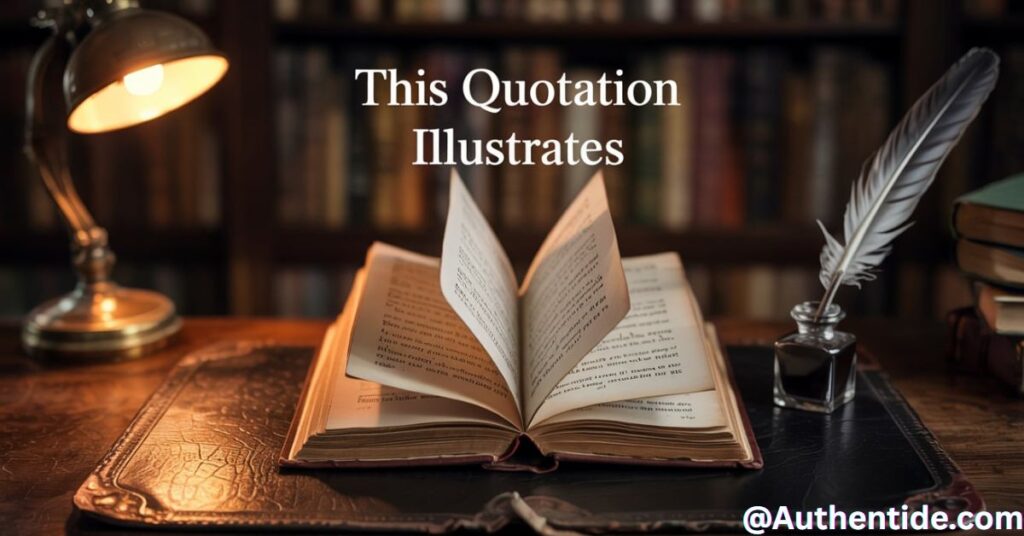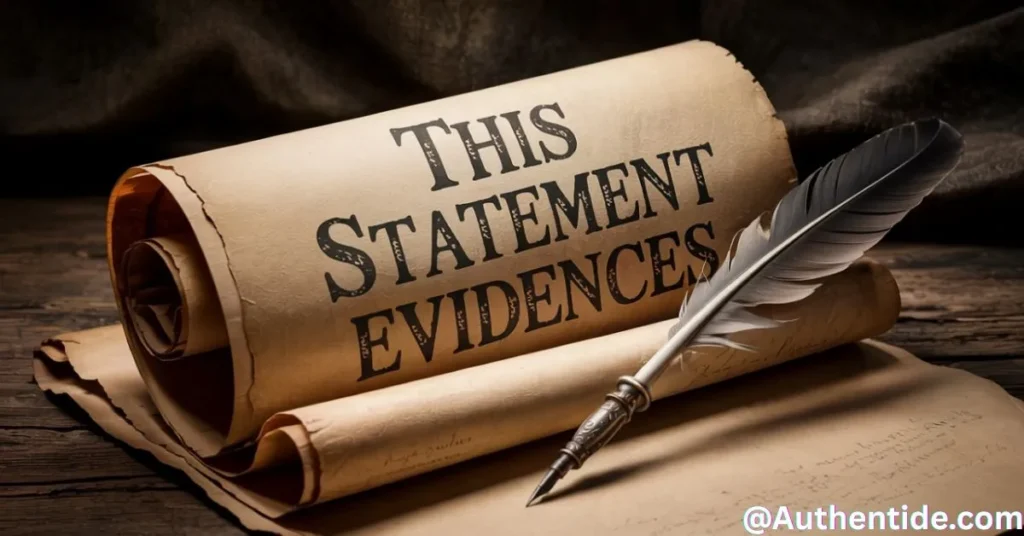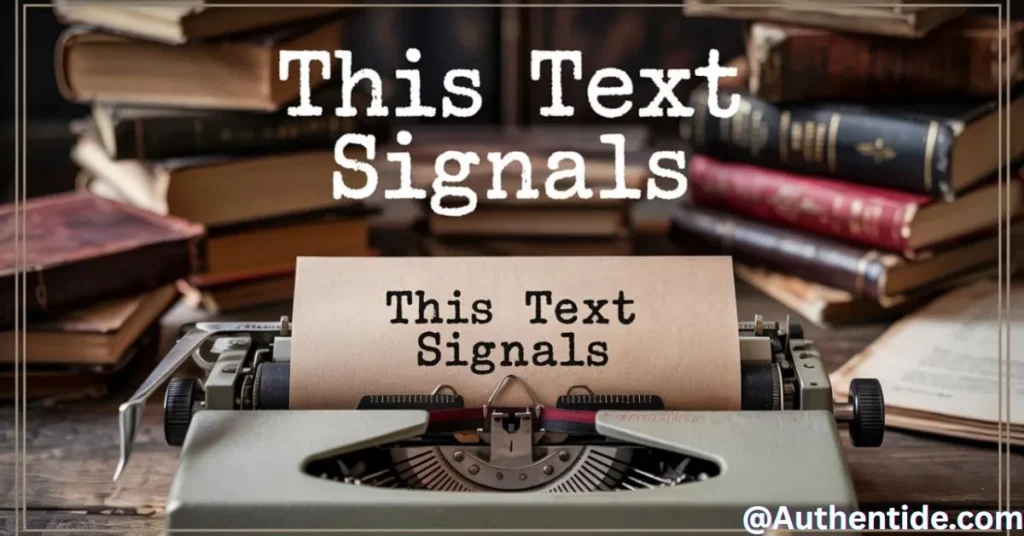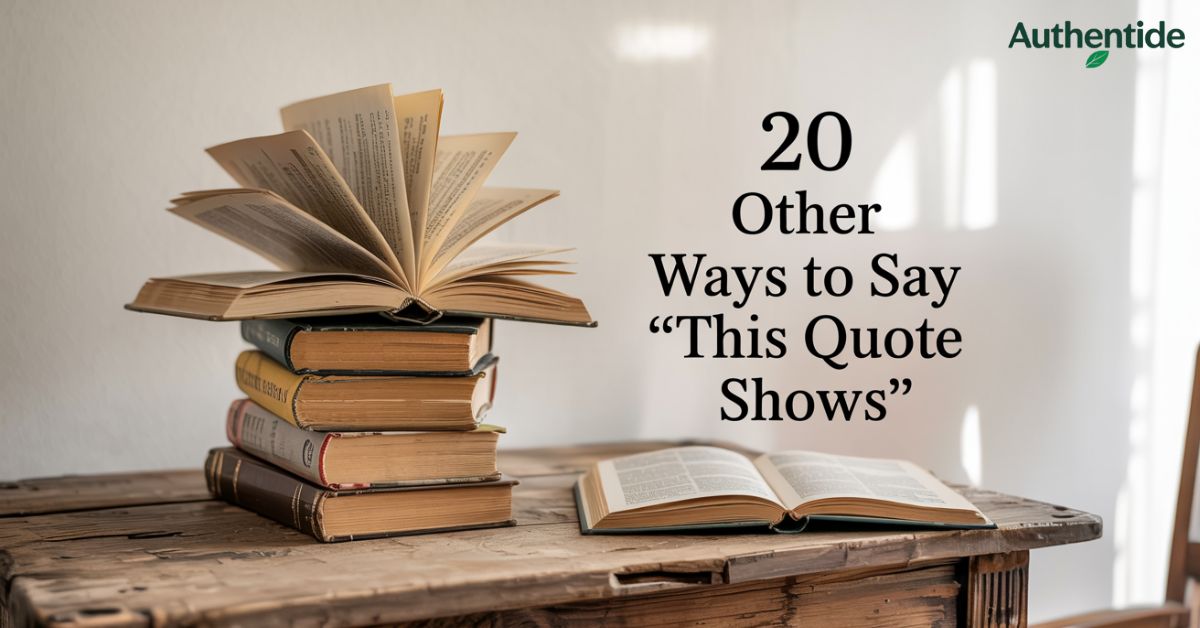This quote shows a fascinating window into how we express meaning, doesn’t it? Imagine you’re at a bustling coffee shop, overhearing a writer scribble notes for their next big novel. They pause, sip their latte, and mutter, “How else can I say this quote shows without sounding like a broken record?” That’s where the magic of language kicks in variety spices up writing like cinnamon in your morning brew. Whether you’re crafting an email, a blog post, or a heartfelt letter, finding fresh ways to introduce a quote keeps your reader hooked. Let’s dive into 20 creative alternatives that’ll make your words pop off the page.
Language is a playground, and swapping out tired phrases like “this quote shows” for something zesty can transform your writing from mundane to memorable. Think of it like swapping a plain t-shirt for one with a bold graphic same message, way more flair. These alternatives don’t just shuffle words around; they add depth, tone, and personality to your ideas. Plus, with examples tailored to real-life scenarios, you’ll see exactly how to wield them like a pro.
Why settle for the same old phrasing when you can paint with a broader palette? From emails to essays, these 20 options paired with vivid scenarios will arm you with tools to captivate your audience. By the end, you’ll wonder why you ever leaned so hard on “other ways to say this quote shows” when there’s a whole world of expression waiting. Ready to explore? Let’s get started.
What is Instead of “This Quote Shows”
- This Quotation Illustrates
- This Excerpt Demonstrates
- The Passage Reveals
- This Citation Highlights
- These Words Underscore
- This Statement Evidences
- This Excerpt Exemplifies
- The Quote Delineates
- These Lines Indicate
- This Snippet Reflects
- This Quotation Represents
- These Words Convey
- This Quote Depicts
- The Passage Explains
- These Lines Clarify
- This Phrase Suggests
- This Selection Portrays
- This Text Signals
- These Sentences Emphasize
- This Expression Captures
20 Creative Alternatives to “This Quote Shows”
Here are 20 Creative Alternatives to “This Quote Shows” (With Example):
1. This Quotation Illustrates

When you want to paint a picture with words, this quotation illustrates steps up. It’s like handing your reader a magnifying glass to zoom in on the idea.
- Scenario: Email to a colleague
Subject: Project Update
Hi Sarah,
I came across something inspiring today. “Success is the sum of small efforts, repeated day in and day out.” This quotation illustrates why our daily grind is paying off those Little wins are stacking up! Thoughts?
Best,
Jake
2. This Excerpt Demonstrates
Needs to prove a point with flair? This excerpt demonstrates flexes some muscle, showing evidence in action.
- Scenario: Team meeting notes
“Teamwork makes the dream work.” This excerpt demonstrates how our collaboration last quarter crushed those sales targets. Let’s keep the momentum going!
3. The Passage Reveals
For a touch of mystery, the passage reveals peels back layers like an onion, inviting curiosity.
- Scenario: Blog comment
Hey Lisa, loved your post! “The best views come after the hardest climbs.” The passage reveals why persistence beats talent every time—reminds me of my hike up Mount Rainier last summer.
4. This Citation Highlights
Shine a spotlight on key ideas with this citation highlights. It’s like underlining a sentence in neon.
- Scenario: Research paper draft
“Knowledge is power.” This citation highlights the urgency of education reform—stats show literacy rates still lag in rural areas.
5. These Words Underscore
When you want to hammer a point home, these words underscore adds weight, like bolding text in your mind.
- Scenario: Text to a friend
Yo Mike, check this out: “Time is the currency of life.” These words underscore why I’m ditching late-night gaming for early workouts. You in?
6. This Statement Evidences

For a lawyerly vibe, this statement evidences lays out the proof, no objections allowed.
- Scenario: Legal memo
To: Attorney Patel
“Justice delayed is justice denied.” This statement evidences the need to expedite case 4032—clients are restless.
7. This Excerpt Exemplifies
Show off a perfect example with this excerpt exemplifies. It’s like holding up a gold-star model.
- Scenario: Teacher’s feedback
Dear Emily,
“Curiosity is the wick in the candle of learning.” This excerpt exemplifies your stellar questions in class today keep it up!
8. The Quote Delineates
To sketch out an idea clearly, the quote delineates draws the lines like a blueprint.
- Scenario: Project proposal
“Simplicity is the ultimate sophistication.” The quote delineates our minimalist design approach—clean lines, bold impact.
9. These Lines Indicate
Subtle yet sharp, these lines indicate points the way like a compass needle.
- Scenario: Social media post
“Laughter is the best medicine.” These lines indicate why I’m bingeing stand-up specials this weekend—stress who?
10. This Snippet Reflects
For a mirror-like effect, this snippet reflects bounces the idea back with clarity.
- Scenario: Journal entry
“The journey is the reward.” This snippet reflects how I felt finishing that 5K—sore legs, huge grin.
11. This Quotation Represents
Symbolism shines with this quotation represents, standing tall like a flag.
- Scenario: Speech draft
“Hope is the thing with feathers.” This quotation represents our community’s resilience after the storm—unshakable.
12. These Words Convey

Smooth and flowing, these words convey carries the message like a river.
- Scenario: Customer email
Hi Tom,
“Quality over quantity.” These words convey why we’re tweaking your order—fewer pieces, better craftsmanship. Cool?
Regards,
Mia
13. This Quote Depicts
Paint a vivid scene with this quote depicts, like a movie still in words.
- Scenario: Art critique
“Every artist was first an amateur.” This quote depicts Van Gogh’s early sketches—messy, but full of heart.
14. The Passage Explains
Clarity is king with the passage explains, breaking it down like a patient teacher.
- Scenario: Study group chat
Hey guys, “Practice makes perfect.” The passage explains why we’re acing these quizzes—reps matter!
15. These Lines Clarify
Wipe away the fog with these lines clarify, making muddy waters crystal clear.
- Scenario: FAQ response
“Less is more.” These lines clarify why our new app skips the bloat speed over clutter.
16. This Phrase Suggests
A gentle nudge comes with this phrase suggests, hinting without shouting.
- Scenario: Book club email
Hi Rachel,
“Books are a uniquely portable magic.” This phrase suggests why we should pick The Night Circus next—thoughts?
Cheers,
Ben
17. This Selection Portrays
For a dramatic flair, this selection portrays sets the stage like a play.
- Scenario: Theater review
“All the world’s a stage.” This selection portrays Shakespeare’s knack for blending life and drama—brilliant!
18. This Text Signals

Pointing ahead like a road sign, this text signals guides the reader forward.
- Scenario: Marketing pitch
“Innovation distinguishes leaders.” This text signals why our gadget’s a game-changer—competitors beware.
19. These Sentences Emphasize
Double down on impact with these sentences emphasize, like a drumbeat in prose.
- Scenario: Motivational poster
“You miss 100% of the shots you don’t take.” These sentences emphasize grabbing every chance—go for it!
20. This Expression Captures
Wrap it up neatly with this expression captures, bottling the essence like lightning in a jar.
- Scenario: Wedding toast
“Love is friendship set on fire.” This expression captures why Jen and Mark glow tonight—cheers to them.
Pro Tips: The Most Important Paragraph
The third paragraph of the introduction stands out as the crown jewel of this article. Why? It hooks you with a promise 20 fresh alternatives paired with real-world scenarios and sets the tone for what’s ahead. It’s the moment where curiosity ignites, nudging you to think, “Hey, I could use these!” That blend of excitement and practicality makes it the linchpin, bridging the “why” of variety with the “how” of application. Without it, the article risks feeling like a dry list; with it, you’re primed for a fun, useful ride.
- Keep it relatable: Tie the promise to everyday writing needs.
- Spark intrigue: Hint at the goodies (like scenarios) without spilling all the beans.
- Set expectations: Let readers know they’ll walk away with tools, not just trivia.
Why Vary Your Phrasing?
Ever read something that repeats the same phrase like “this quote shows” until your eyes glaze over? Variety keeps your writing alive. It’s like seasoning a dish; too much salt (or one phrase) ruins the flavor. Using other ways to say this quote shows think “this excerpt demonstrates” or “these lines indicate” shows off your chops and keeps readers engaged. Plus, it fits the vibe formal for reports, casual for chats. Who doesn’t want their words to sing instead of drone?
When to Use These Alternatives
Timing’s everything. Drop “this quotation illustrates” in an essay to sound polished, or use “this snippet reflects” in a journal for a personal touch. Context rules—“the passage reveals” fits a deep dive, while “these words convey” flows in a quick email. Match the phrase to your audience and goal. A boss might love “this statement evidences” in a memo, but your buddy might vibe more with “this quote depicts” over beers.
How Do These Phrases Differ?
Take “these words underscore” versus “this citation highlights”. The first digs in, stressing importance like a teacher circling a key point. The second shines a light, drawing your eye like a flashy billboard. Or compare “this excerpt exemplifies” a textbook example to “the quote Delineates”, which maps out the idea like a guide. Each carries a unique flavor; pick one that matches your intent and watch your writing level up.
Are These Phrases Formal Enough?
Worried about sounding too casual? Most of these like “this quotation represents” or “this statement evidences” fit snugly in formal writing, from papers to proposals. Others, say “this snippet reflects”, lean conversational perfect for blogs or emails. Test the waters: if it feels stuffy or too loose, swap it out. Flexibility’s the name of the game; you’ve got options for every occasion.
Benefits of Switching It Up
Ditching “other words for this quote shows” for “this selection portrays” isn’t just cosmetic it is strategic. It sharpens your voice, cuts monotony, and signals you’ve got range. Readers notice. A varied toolbox like “this text signals” or “these sentences emphasize” lifts your credibility and keeps them reading. It’s like upgrading from a flip phone to a smartphone; same job, way better delivery.
Frequently Asked Question
How to not say this quote shows?
Instead of saying “this quote shows,” use alternatives like:
- “This statement reveals…”
- “These words highlight…”
- “The author emphasizes…”
- “This passage illustrates…”
- “These lines convey…”
How to explain a quote without saying this show?
To explain a quote without saying “this shows,” try using more specific and insightful phrases like:
- “This suggests that…”
- “The author implies that…”
- “This reflects the idea that…”
- “These words indicate…”
- “This highlights the importance of…”
- “This demonstrates how…”
- “Here, we see that…”
What can I use instead of a quote?
Instead of a quote, you can use:
- Paraphrasing – Restate the author’s idea in your own words.
Example: Instead of quoting, say: “The author argues that bravery often stems from fear.” - Summary – Give a brief overview of a larger section.
Example: “The paragraph explains how the character evolves through hardship.” - Data or Statistics – Use factual evidence when relevant.
Example: “Studies show that 85% of readers prefer emotionally driven stories.” - Examples or Anecdotes – Use real or fictional scenarios to support your point.
- Visuals – Charts, graphs, or images can also replace lengthy quotes in some formats.
How to explain evidence without saying this shows?
To explain evidence without saying “this shows,” try using these natural and engaging alternatives:
- “This suggests that…”
- “The evidence points to…”
- “This indicates…”
- “From this, we can infer…”
- “This supports the idea that…”
- “It becomes clear that…”
- “This highlights…”
- “This reinforces the claim that…”
How to avoid saying this essay will?
To avoid saying “this essay will,” rephrase the sentence to sound more natural and engaging. Here are some alternatives:
- “In exploring [topic], we’ll uncover…”
- “This discussion focuses on…”
- “The following sections examine…”
- “A closer look reveals…”
- “This analysis demonstrates…”
- “We begin by understanding…”
- “Through this lens, we explore…”
Conclusion
These 20 other ways to say “this quote shows” offer fresh, compelling alternatives that elevate your commentary and strengthen your arguments. Whether you’re crafting an academic essay, a blog post, or a literary analysis, varying your language keeps your writing engaging and dynamic.
From phrases like “this statement highlights” to “these words reveal,” each alternative allows you to express insight with greater clarity and style. So next time you’re quoting a source, try one of these expressions to make your point stand out and leave a lasting impression on your reader.

Your go-to place for smart synonyms and celebrity updates. Muhammad Hassan Abid is dedicated to creating useful, engaging content that informs, inspires, and truly serves your curiosity

